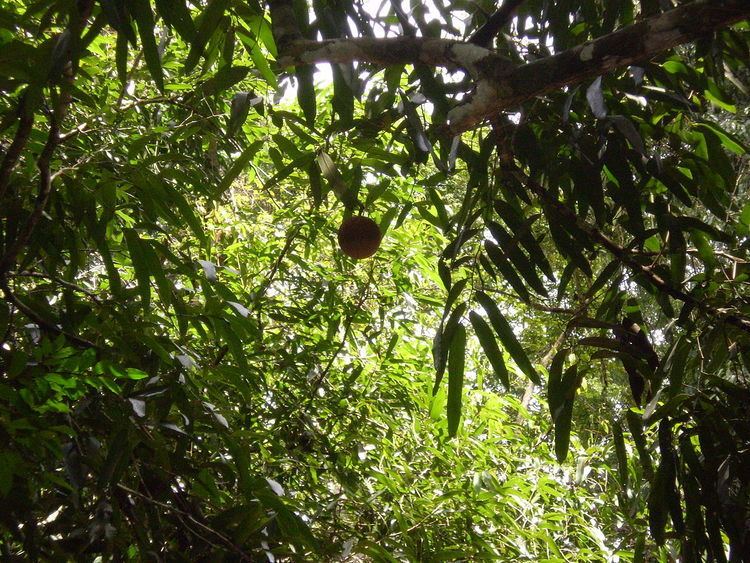 | ||
Hydnocarpus wightiana or Chaulmoogra is a tree in the Achariaceae family. The oil from its seeds has been widely used in Indian medicine and Chinese traditional medicine for the treatment of leprosy. It entered early Western medicine in the nineteenth century before the era of sulfones and antibiotics for the treatment of several skin diseases and leprosy.
Contents
Physical characteristics and composition
The oil is semi-solid at room temperature and does not have a strong odor. Gas–liquid chromatography analysis has shown the oil to contain the following fatty acids - hydnocarpic acid, chaulmoogric acid, gorlic acid, lower cyclic homologues, myristic acid, palmitic acid, stearic acid, palmitoleic acid, oleic acid, linoleic acid and linolenic acid.
Medical use
The active ingredient that produces antimicrobial activity has been identified as hydnocarpic acid, a lipophilic compound. It acts by being an antagonist of biotin. The oil was used intravenously or intramuscularly in the early part of the twentiety century against leprosy. An ethyl ester of the oil was developed by Alice Ball in 1916 which led to the preparation and marketing of it by Burroughs Wellcome in the early 1920s. This was also used intravenously for leprosy patients often producing local reactions. The oil was also often obtained directly from India by several doctors in Africa, such as the East African Rift. The doctors would locally prepare ethyl esters to treat their patients. In June 1927, Burroughs Wellcome released the commercial preparation, sodium hydnocarpate marketed as Alepol, which produced lesser disagreeable symptoms of pain, swelling, irritating cough and blocking of the veins. In May 1928, doctors reported cure of leprosy in some patients after treatment with alepol
The oil contains 5′-methoxyhydnocarpin, an amphipathic weak acid. Although a minor component in the oil with no antimicrobial activitiy on its own, it plays a role in preventing multidrug resistance among some bacteria such as Staphylococcus aureus. It potentiates the action of berberine by preventing its removal from within bacteria thus leading to accumulation of berberine in the cells. Several berberis medicinal plants producing berberine also synthesize an inhibitor of the multidrug resistance pump of a human pathogen Staphylococcus aureus. Berberine alkaloids, which are cationic antimicrobials produced by a variety of plants, are readily extruded by multidrug resistance pumps. They are constituents of several Native American herbal medicine preparations. By extracting and using hydnocarpic acid only, western medicine could not utilise the action of the other ingredients of the oil which have been now shown to have synergistic antimicrobial activity.
In view of its anti-mycobacterial activity, it has also been tried on other conditions caused by mycobacteria such as tuberculous laryngitis.
Collection and preprocessing − processing − extraction
Fruits plucked by climbing up to the tree or using long sticks with sickle tied to it. Fruits are peeled by knife and seeds are washed in water, and dried in sun. Seeds are decorticated (dehusked) by mallet, hand hammers or by decoricator. The kernels yield 43% oil in ghani. Also crushed in expeller and rotary. Extracted oil is stored in Zinc barrels and exported
Properties and fatty acid composition
The crude oil is of pale greenish-brown tinged. The oil can be easily into white, watery oil. The oil contains three cyclopentene fatty acids.
Table:fatty acid composition of oil
The oil is used up to 15% in medicated soap .The oil is used internally and externally in leprocy treatment and skin diseases also.
Table of physical properties of oil
